Java程序员自动化指南
一、背景
在Java web开发中,虽然Spring boot已经帮助我们简化了很多工作,但项目中庞杂的业务仍然需要自己去编写较多的 entity,vo,Mapper,Service, Controller 代码等,那么我们有没有什么办法来简化这整个开发流程呢?
二、工具选型
在尝试了部分市场较为主流的自动化工具后,还是选择了diboot-devtools这个开发者工具 ,因为她:
- 专门为springboot开发,引入依赖,配置好相对路径即可使用;
- 并且支持较为常用的五种数据库(MySQL,ORACLE,SQLServer,PostgreSQL,MariaDB);
- 代码自动生成到项目相应的目录下;
- 数据库表结构更改后,可以同步更改对应文件的代码,而不影响到你自己写的代码;
- 基础框架中依靠注解实现的数据关联(一对一、一对多、多对多、数据字典关联等),将关联问题简单化了;
- 对数据关联设置简单,代码生成与更新也可以自动支持一对一、一对多、多对多、数据字典关联;
- 支持开发以及维护过程中对数据库相关表的数据结构更改进行记录,并写入到对应的数据库更改日志文件中;
- 支持启用lombok的代码形式;
- 支持启用swagger的项目;
- 依赖少、简便轻量、灵活性高;
- Github地址为 https://github.com/dibo-software/diboot-v2/ ,官网为 https://www.diboot.com/ 。
三、开始使用
- 在 https://start.spring.io/ 下载一个初始项目demo.zip并解压导入到IDEA。
- 访问 https://mvnrepository.com/artifact/com.diboot/diboot-devtools-spring-boot-starter 链接可以看到devtools的所有版本,点击一个最新版本进去,复制maven或者gradle的依赖配置,因为官方不建议打包到生产环境,所以maven中添加<scope>provide</scope>参数,gradle中也做相应处理即可。
- 因为其中关联绑定是使用了diboot-core-starter中的相关绑定类,所以还需要引入diboot-core-starter,访问 https://mvnrepository.com/artifact/com.diboot/diboot-core-spring-boot-starter 可以看到diboot-core-spring-boot-starter的所有版本,选择和devtools一致的版本即可。
<dependency>
<groupId>com.diboot</groupId>
<artifactId>diboot-devtools-spring-boot-starter</artifactId>
<version>2.0.3-RC2</version>
<scope>provide</scope>
</dependency>
<dependency>
<groupId>com.diboot</groupId>
<artifactId>diboot-core-spring-boot-starter</artifactId>
<version>2.0.3-RC2</version>
</dependency>
- 根据自己项目情况设置配置文件
server.port=8080 server.servlet.context-path=/example #datasource config spring.datasource.url=jdbc:mysql://localhost:3306/demo?characterEncoding=utf8&serverTimezone=GMT%2B8 spring.datasource.username=root spring.datasource.password=xxxx spring.datasource.hikari.driver-class-name=com.mysql.cj.jdbc.Driver spring.datasource.hikari.maximum-pool-size=5 spring.main.allow-bean-definition-overriding=true # devtools config diboot.devtools.codes-author=xxx diboot.devtools.codes-copyright=xxxx.com diboot.devtools.codes-version=1.0.0 diboot.devtools.output-path-entity=demo/src/main/java/com/example/demo/entity/ diboot.devtools.output-path-vo=demo/src/main/java/com/example/demo/vo/ diboot.devtools.output-path-service=demo/src/main/java/com/example/demo/service/ diboot.devtools.output-path-mapper=demo/src/main/java/com/example/demo/mapper/ diboot.devtools.output-path-controller=demo/src/main/java/com/example/demo/controller/ diboot.devtools.output-path-sql=demo/src/main/resources/ diboot.devtools.enable-lombok=false diboot.devtools.enable-swagger=false
- 启动项目,项目启动后,会出现以下日志,点击打开这个链接即可访问到devtools对于项目的配置界面:

四、代码生成
- 点击如下:heavy_plus_sign:按钮,添加一张数据表:
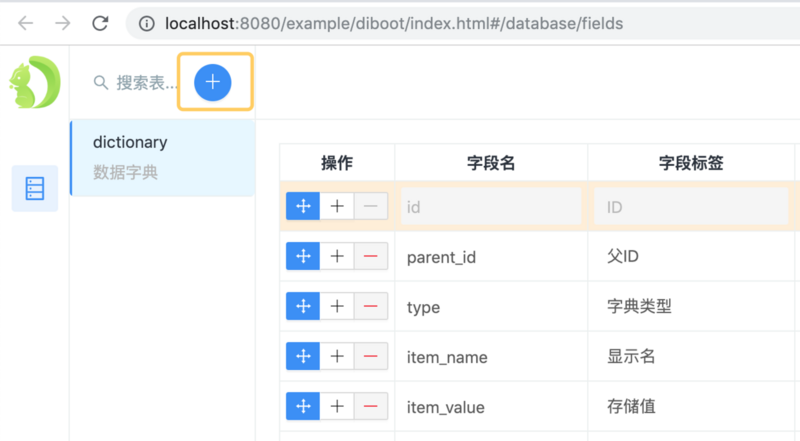
- 添加一张案例表, 其他先使用默认即可:
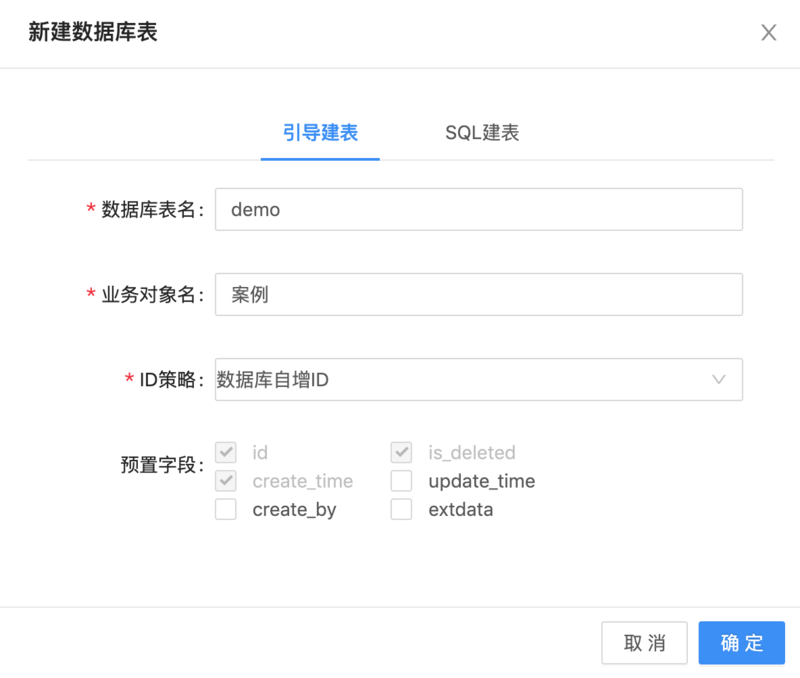
- 在数据表管理中添加一个字段name,设置样例数据,然后点击右上角的更新数据库并生成代码:

- 可以看到相关的代码文件已经生成了:
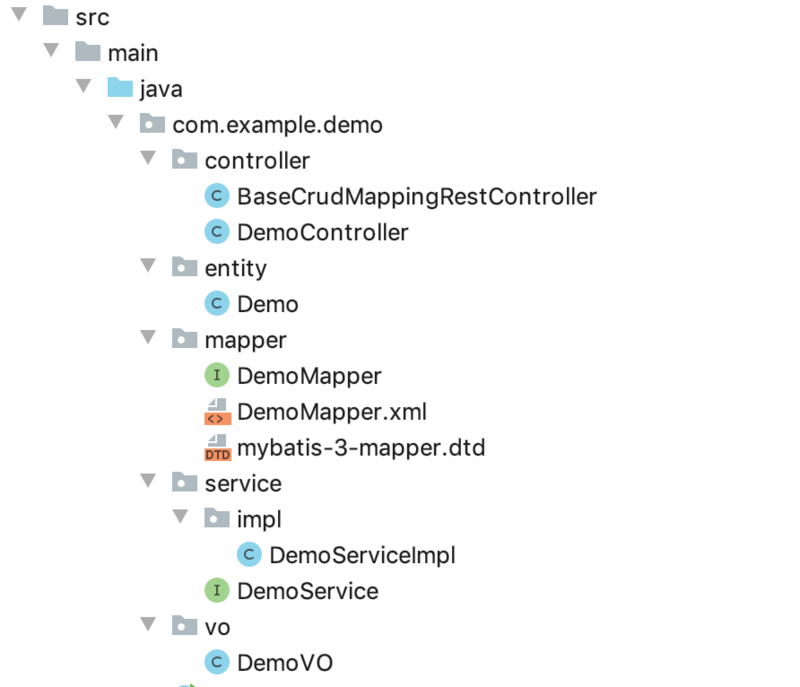
- 重启应用,访问接口地址 http://localhost:8080/example/demo/list 便可以获取到该表的列表数据:
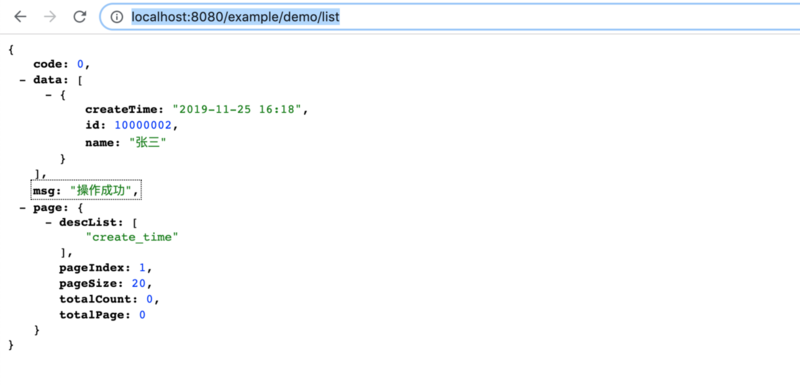
五、代码更新
- 在demo.java的entity中增加一个count字段,测试更新代码功能:
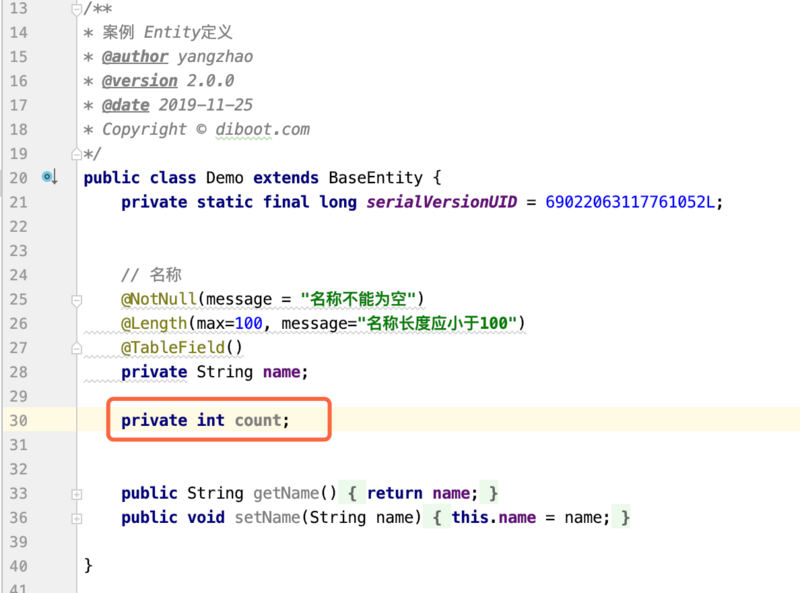
- 在数据库配置页面,在demo表中增加一个title字段,并点击右上角更新数据库和代码。

- 可以看到代码已经更新完成,并没有影响到自己添加的字段:
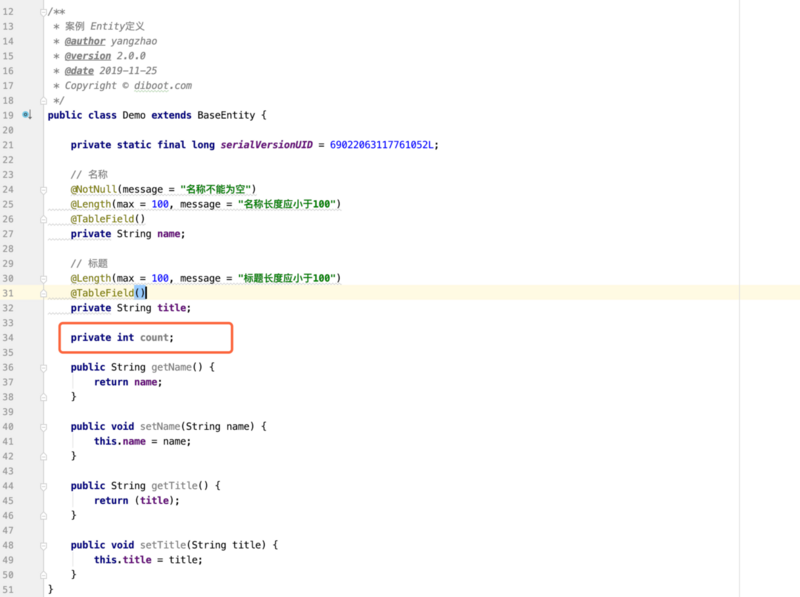
六、关联自动化
在他们之前发布的diboot-core中就已经支持了关联无SQL的注解绑定方式,可见 https://github.com/dibo-software/diboot-v2/tree/master/diboot-core ,省去了编写关联代码,以及性能调优的相关麻烦,这次的devtools又将这些关联做到了自动化,已经不再写关联代码就能轻松实现业务数据的多种关联关系了。
数据字典关联
- 新建一个status字段,并设置关联为数据字典关联,先添加一个数据字典数据以供测试:

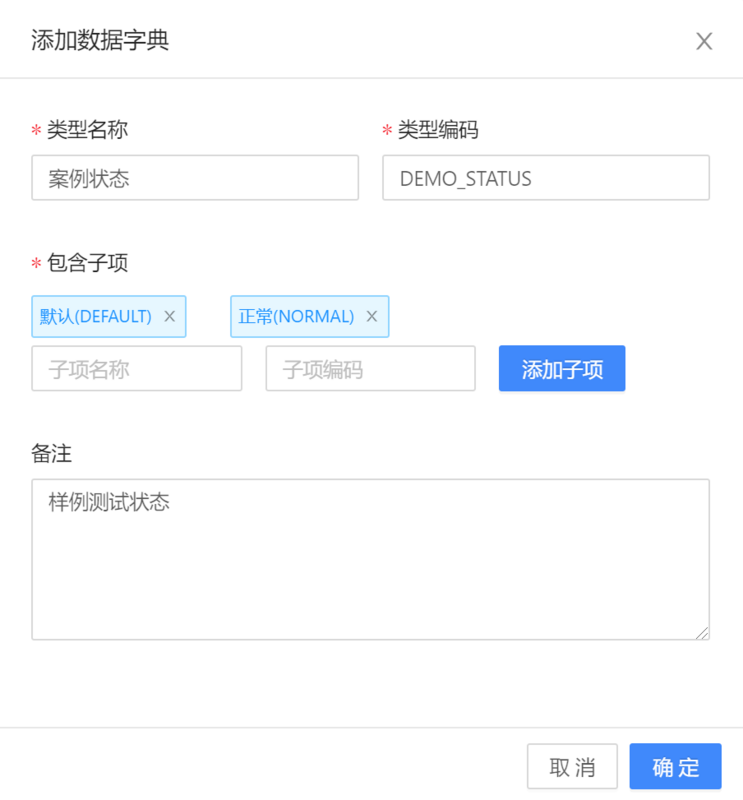
- 添加好数据字典数据后,选择该数据字典类型,以及该字段对应的数据字典样例数据,然后提交更新数据库生成代码(这里更新代码也是支持的)。

- 关联相关代码将会生成或更新到vo代码中,会自动完成status字段对数据字典的关联关系的绑定操作,如下:
public class DemoVO extends Demo {
private static final long serialVersionUID = -4435060215996407737L;
// status字段的关联数据字典
public static final String DICT_DEMO_STATUS = "DEMO_STATUS";
// 关联数据字典:DEMO_STATUS
@BindDict(type=DICT_DEMO_STATUS, field="status")
private String statusLabel;
public String getStatusLabel() {
return statusLabel;
}
public void setStatusLabel(String statusLabel) {
this.statusLabel = statusLabel;
}
}
- 访问接口,验证关联关系绑定,可以看到下图中已经显示出了目标字段 statusLabel 的值:
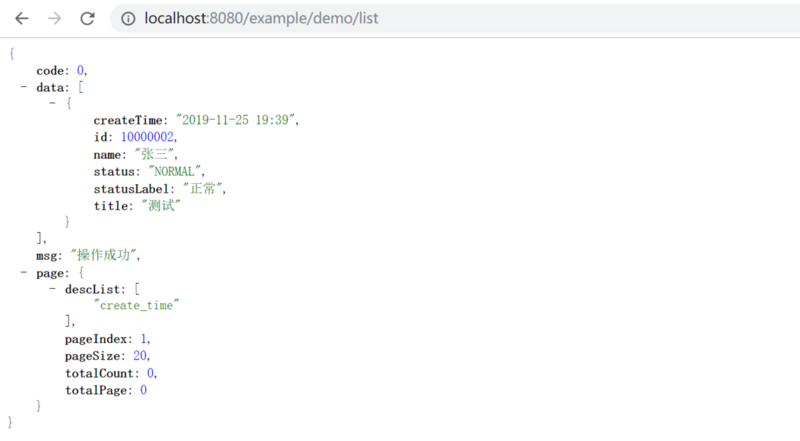
一对多关联
- 新建关联测试表demo_rel,并新建字段demo_id,设置与demo表的一对多关联关系:

- 点击右上角“更新数据库&生成代码”提交,开始生成该表的相关的代码,可以看到vo中也对这个一对多的关联关系进行了注解的自动绑定:
public class DemoRelVO extends DemoRel {
private static final long serialVersionUID = 943963213889204702L;
// 字段关联:this.demo_id=id
@BindField(entity = Demo.class, field = "name", condition = "this.demo_id=id")
private String demoName;
public String getDemoName() {
return demoName;
}
public void setDemoName(String demoName) {
this.demoName = demoName;
}
}
- 对该表的接口进行简单验证,可以看到已经关联了demo表,并显示了目标name字段的关联值:
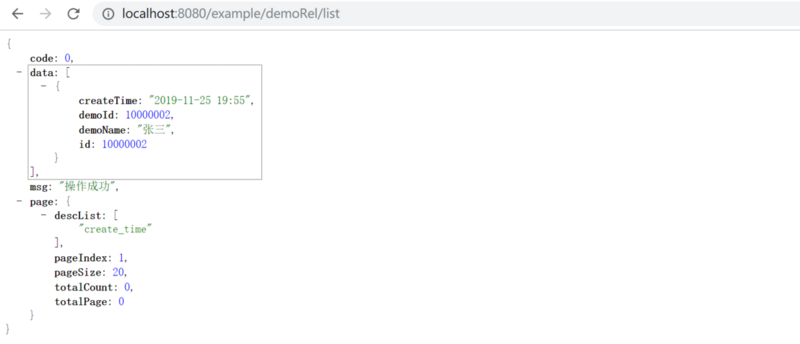
多对多关联
多对多关联需要借助中间表来进行多对多的数据关联,但这一切devtools都帮我们想好了,自动生成中间表。
- 先创建两张表user和role表,以及相关字段如下所示:


- 在user表中设置user和role表多对多关联,并生成代码:

- 可以看到在vo中已经通过注解自动绑定了多对多的关联关系:
public class UserVO extends User {
private static final long serialVersionUID = -8863290616176144787L;
// 通过中间表的多-多Entity实体关联
@BindEntityList(entity = Role.class, condition="this.id=user_role.user_id AND user_role.role_id=id AND user_role.is_deleted=0")
private List<Role> roleList;
public List<Role> getRoleList() {
return roleList;
}
public void setRoleList(List<Role> roleList) {
this.roleList = roleList;
}
}
- 更新user_role表的样例数据(此处初始id为10000002,也需要手动改下role_id的字段标签),并更新数据库(此处不需要生成代码):

*~~~~ 重启应用后,访问user的列表接口,即可看到关联数据的结果了:
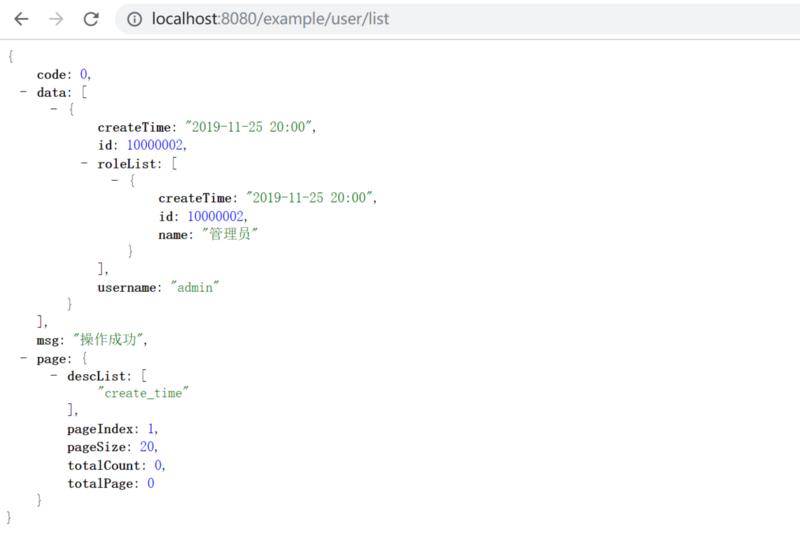
七、结语
以上是对diboot devtools的一些基础的使用方法及效果的介绍,还有很多方面没有介绍到,其他功能比如对swagger、对lombok等的支持,各位小伙伴可以先自我尝试下,希望本文对各位小伙伴有所帮助,祝猿媛们多多提高效率,专注与工作中那些更加核心的部分,也少些加班,多些时间陪陪家人哦~~~ 如果您喜欢不妨 点赞、收藏、分享 三连哦,纯手打,万分感谢!
正文到此结束
- 本文标签: 配置 Master App 测试 example tar bean IDE 专注 spring 一对多 servlet http map 希望 时间 root dataSource Service 数据 springboot 目录 参数 maven core sql IO 代码 web 同步 https 下载 开发者 Spring Boot mysql list 自动化 entity 数据库 自动生成 GitHub GMT zip final git Word UI id 程序员 db src Oracle mapper 管理 JDBC java 开发 ip 加班
- 版权声明: 本文为互联网转载文章,出处已在文章中说明(部分除外)。如果侵权,请联系本站长删除,谢谢。
- 本文海报: 生成海报一 生成海报二
热门推荐
相关文章
Loading...











![[HBLOG]公众号](https://www.liuhaihua.cn/img/qrcode_gzh.jpg)

